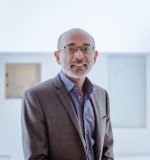DeWitt Stetten, Jr. Lecture
Established by NIGMS in 1982 and presented annually in honor of Dr. Stetten, the third NIGMS director, this annual lecture is part of the Wednesday Afternoon Lecture Series.

Rethinking General Anesthesia
We have established a systems neuroscience (conceptual, experimental, data analysis and modeling) paradigm for studying the mechanisms of general anesthesia-induced loss of consciousness.

Scalable Platforms for Generating RNA Sensors and Controllers
Whether animals are looking for food or mates, or avoiding pathogens and predators, they rely on biosensors—molecules that allow animals to sense and respond to their environments. Creating new kinds of biosensors to receive, process, and transmit molecular information is the focus of Dr. Smolke’s research. Her innovative approaches for designing biomolecules have applications in diagnostics, drug development, green chemistry, and more. Her lab has created RNA molecules, or switches, that can detect the disease state of a cell.

Understanding the source of regenerative ability in animals
Salamanders and starfish might be “simpler” than humans, but they far surpass us in one major way—the ability to regenerate tissues and regrow lost limbs. Dr. Sánchez Alvarado studies regeneration using the flatworm planaria Schmidtea mediterranea. Remarkably, when halved or quartered this organism can clone itself from the pieces. More than 100 years ago, that feat captured the attention of geneticist Thomas Hunt Morgan, who studied planarians years before his famed work on fruit flies. As astonishing as the planarian regenerative capacities are, Dr.

Computing cures: discovery through the lens of a computational microscope
Dr. Amaro’s scientific interests lie at the intersection of computer-aided drug discovery and biophysical simulation methods. She has a long-standing interest in incorporating structural and dynamical information derived from all-atom molecular dynamics simulations in drug discovery programs, and has worked in a variety of disease areas, including infectious diseases and cancer. Her lab’s work on p53 revealed a novel druggable pocket that clarified the mechanism of action for a compound in clinical trials.

Elements of health and disease: inorganic fluxes and metal receptors that control cell fate decisions
For the past three decades, Thomas V. O'Halloran has investigated how fluctuations in the amount of metal ions inside cells influence key cellular decisions. Using genetic, chemical, structural, and mechanistic approaches, he has uncovered new types of metal receptors and tied their function to a number of disease-related physiological processes. O'Halloran identified early examples of metal ion receptors called metalloregulatory proteins that regulate gene expression.

Form meets function: Structurally diverse cilia and their roles in sensory signaling
Primary cilia are microtubule-based organelles that are now known to be present on nearly all differentiated cell types in metazoans. Cilia house signaling molecules that transduce environmental cues and regulate cellular homeostasis and organismal development. Disruption of cilia structure or function is linked with a plethora of diseases termed ciliopathies, many of which are characterized by sensory defects.

The mechanisms of cytoskeletal motor proteins
Movement is a fundamental property of living organisms. The contraction of muscles, beating of cilia and flagella, segregation of genetic material during mitosis, and intracellular transport of membranes, proteins and mRNAs are driven by molecular motor proteins that move along cytoskeletal filaments. Dr. Vale’s laboratory, whose research is funded by NIH, has studied kinesin and dynein, the two types of motors that move along microtubule tracks.
The page was last updated on Thursday, January 29, 2015 - 2:31pm




